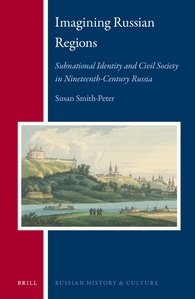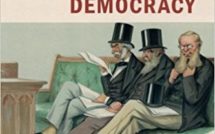
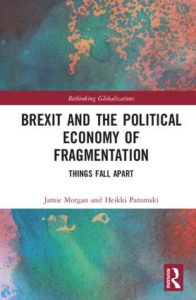 Brexit and the Political Economy of Fragmentation
Brexit and the Political Economy of Fragmentation
Edited by Jamie Morgan, Heikki Patomaki
Publisher: Routledge
Recommended by Malcolm Campbell-Verduyn
Following the day-to-day negotiations of Britain’s departure from the European Union can be a disorienting and downright confusing affair. The inability of the UK government to chart a coherent path for the country outside of the Union, along with the myriad challenges facing the EU as cohesive club of more than two-dozen nation-states contribute profound uncertainty over the future political and economic direction of Europe more generally. In debates where less than analytic speculation has tended to reign Brexit and the Political Economy of Fragmentation provides much-needed scholarly analysis from a range of social scientific perspectives. Editors Jamie Morgan and Heikki Patomäki bring together leading minds in Economics, European Studies, and International Political Economy into a volume that provides important and varied understandings of the tendencies towards both integration and disintegration in European and wider global political economy.
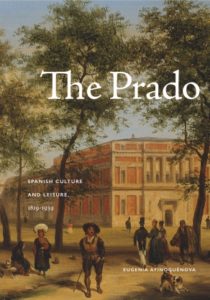 The Prado: Spanish Culture and Leisure, 1819-1939
The Prado: Spanish Culture and Leisure, 1819-1939
By Eugenia Afinoguénova
Publisher: The Pennsylvania State University Press
Recommended by Louie Dean Valencia-García
Eugenia Afinoguénova’s The Prado: Spanish Culture and Leisure, 1819-1939 is a book that tells the history of Spain’s long nineteenth century and the tension between the aristocracy of old, the Bourbon dynasty, and the ways everyday Spaniards negotiated liberalism in that century. As historian Adrian Shubert points out in his A Social History of Modern Spain (Routledge, 1996), between 1812 and 1914, Spain had more years of constitutional, representative government than any continental European country, including France, if one considers the twenty years of the Second French Empire. The book, overflowing with maps and illustrations, covers the Prado museum’s nearly 200 years of history as a space which has communicated between diverse audiences—aristocracy, a burgeoning bourgeoisie, and the masses. Afinoguénova’s book shows the ways that modern constructions of Spanishness and leisure were interpreted through carnival celebrations that threatened to bring the plebe into élite spaces, such as the Prado, and the urban spaces surrounding the museum.
Afinoguénova convincingly argues that because literacy rates were so low in Europe, with the exception of the Nordic countries, that “late nineteenth-century definitions of nationhood still had to be communicated visually.” Imbedded in this argument is a claim that challenges scholars to think of the role that visual culture has in the creation of nationalism, and not just printed text as Benedict Anderson has argued. By understanding art, public institutions such as museums, and civic celebrations we can gain new insight into the world we inhabit and the things we exhibit. In its epilogue, the author describes Nazi bombings of the Prado, and the absolutely spellbinding plans to protect the museum and its collections during the Spanish Civil War. Afinoguénova writes, “Emphasizing the civil maturity of common Spaniards…artists, poets, and writers as famous as Picasso… asserted that the Prado was saved by illiterate militiamen who understood the importance of art without understanding art itself.” Afinoguénova’s harrowing story of the Prado museum and its role in creating a more inclusive Spain is both engaging and an important reminder of the role of public institutions, such as museums, in promoting pluralism in liberal democracies even despite often complicated origins.
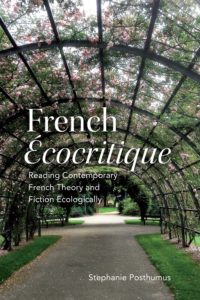
French écocritique: Reading contemporary French theory and fiction ecologically
By Stephanie Posthumus
Publisher: University of Toronto Press
Recommended by Hélène B. Ducros
In her treatment of French écocritique, Stephanie Posthumus chooses an unbeaten path by considering literary texts of theory and fiction that do not necessarily focus on nature explicitly. Instead, she posits that ecological thinking must incorporate other types of environments, such as urban or industrial landscapes. She selects four contemporary novelists to help her investigate the concepts of ecological dwelling, ecological subjectivity, ecological politics, and ecological ends. Through a close reading of the writings of Darrieussecq, Lafon, Rufin, and Houellebecq, she inquires into numerous ecological questions and probes into different dimensions of human interactions with the natural world. Importantly, the book engages with the issue of language as it puts French and Anglophone “eco-differences” in conversation, opening the way for consideration of other literary ecological linguistic contexts. As Posthumus explains what is resolutely French about French ecological thinking and its methodologies, the “French effect” illustrates the ways in which the politics of language is a critical shaper of how different cultures apprehend different natures. Not only does this book reach thinkers across an array of disciplines, but it also creates bridges between two prominent cultures of nature, between ecocriticism and écocritique.
Imagining Russian Regions: Subnational Identity and Civil Society in Nineteenth-Century Russia
By Susan Smith-Peter
Publisher: Brill
Recommended by Samantha Lomb
In Imagining Russian Regions, Smith Peter discusses the origins of the creation of distinct provincial identities in European Russia and how this process was encouraged and even promoted by the autocracy as a way to gain information about the territories under its control, to better manage resources and collect taxes. The Tsarist administration under Nicolas I encouraged and even mandated the creation of statistical bureaus, provincial newspapers and agricultural societies, which were staffed not just by nobles, but by priests sons, merchants and in some cases even peasants as a way to get a more thorough understanding of the territories governed. This allowed people in the provinces to become acquainted with their own particularities, customs and history and to speak directly to the government. However, as Smith-Peter notes, these voices changed from merely providing information to demanding participation in government, which the autocracy rejected. This became increasingly isolating to the nobles in particular as they were cut out of decisions on emancipating serfs and the creation of local government. Smith-Peters argues that the autocracy’s fostering of civil society for economic reasons followed by its rejection of political participation by the civil society it had created caused a rift in Russian society that eventually culminated in the revolutions of 1917. An excellent read for anyone interested in the development of regional identity and politics in Russia or the USSR.

